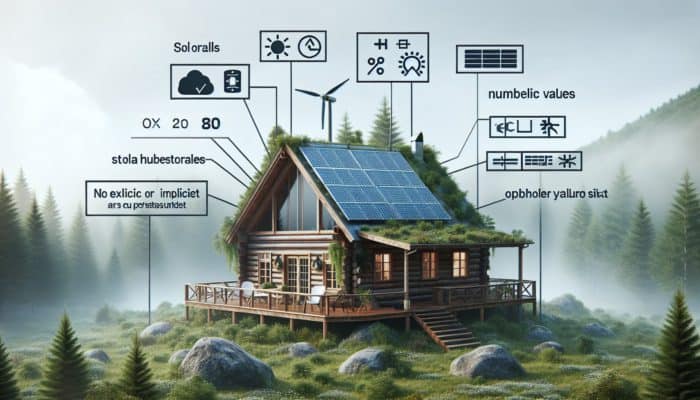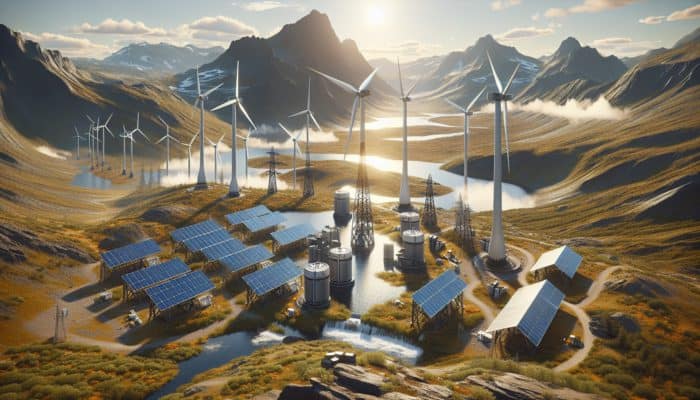In-Depth Exploration of Self-Sufficient Off-Grid Energy Solutions
Understanding the Importance of Off-Grid Power Solutions for Eco-Friendly Living

Off-grid power solutions are innovative energy systems that provide electricity independently from the centralized power grid. These systems are essential for delivering energy to remote or isolated areas where traditional electrical infrastructure is either impractical or completely unavailable. By utilizing renewable energy sources such as solar, wind, and hydropower, off-grid solutions offer a sustainable alternative to conventional fossil fuels. The most prevalent types of off-grid systems include:
- Solar Power Systems for harnessing sunlight
- Wind Power Systems utilizing wind energy
- Hydropower Systems leveraging flowing water
- Biogas Systems converting organic waste
- Diesel Generators for backup energy
- Hybrid Systems combining multiple energy sources
- Battery Storage Systems for energy retention
- Microgrids functioning as localized grids
The fundamental concept behind off-grid power solutions is to empower individuals and communities with energy autonomy, particularly in remote areas like rural Africa or the mountainous regions of South America. This autonomy fosters resilience and sustainability, enabling communities to prosper without relying on external sources of energy.
Discover the Numerous Benefits of Adopting an Off-Grid Lifestyle
Transitioning to an off-grid lifestyle presents an array of benefits that can significantly enhance one’s quality of life. It liberates individuals from the constraints imposed by utility providers, promoting a sense of autonomy and self-sufficiency. Embracing off-grid living encourages sustainability, leading to a substantial decrease in one’s carbon footprint and reduced reliance on depleting resources. This lifestyle not only yields numerous ecological advantages but also fosters personal satisfaction and fulfillment. Key benefits of off-grid living include:
- Independence from Utility Providers for energy security
- Lower Environmental Impact through clean energy
- Enhanced Self-Sufficiency in energy production
- Potential for Significant Cost Savings on energy bills
- Increased Resilience During Emergencies with self-sufficient systems
- Promotion of Sustainable Practices in daily life
- Stronger Connection with Nature through eco-friendly living
- Community Strengthening via shared energy resources
As awareness of these compelling benefits grows, the global movement toward off-grid living is gaining momentum, inspiring more individuals to explore and adopt this transformative lifestyle.
Identifying Challenges in Off-Grid Systems and Effective Solutions
While off-grid power systems offer a multitude of advantages, they also come with specific challenges that require thoughtful consideration. The upfront investment needed for installation can be significant, and continuous maintenance is necessary to ensure systems function at peak efficiency. Moreover, energy generation can vary based on environmental conditions, complicating implementation. However, recent technological advancements are quickly providing effective solutions to address these challenges. Common obstacles and their corresponding solutions include:
- High Initial Costs – Investigate financing options and leverage government incentives to mitigate these expenses.
- Maintenance Requirements – Opt for reliable components and set up service agreements with qualified technicians.
- Variable Energy Supply – Adopt hybrid systems that incorporate diverse energy sources to ensure stability.
- Storage Limitations – Invest in cutting-edge battery technologies to boost energy storage capabilities.
- Regulatory Challenges – Remain informed about local regulations and engage in community efforts to advocate for off-grid solutions.
- Lack of Technical Expertise – Seek professional installation services and training opportunities for DIY enthusiasts.
- Environmental Considerations – Implement sustainable practices during system design and setup to reduce ecological impact.
- Community Engagement – Encourage local support for off-grid initiatives to enhance their viability and success.
By proactively tackling these challenges, individuals can fully capitalize on the significant benefits of off-grid living while contributing to a more sustainable and resilient future.
Detailed Examination of Different Off-Grid Power Systems

How Solar Power Systems Function as Effective Off-Grid Solutions
Solar power systems rank among the most popular off-grid solutions, utilizing photovoltaic panels to transform sunlight into usable electricity. Continuous technological advancements are enhancing both the efficiency and affordability of these solar panels, making them an increasingly appealing choice for various applications. A standard solar power system consists of several essential components: solar panels, an inverter, a charge controller, and battery storage. Each component plays a crucial role in the overall functionality of the system.
In a typical configuration, solar panels capture sunlight, converting it into direct current (DC) electricity. The inverter then converts this DC into alternating current (AC), which is suitable for powering household appliances. The charge controller optimizes battery charging, preventing overcharging and extending battery life. Battery storage is essential, providing energy during periods of insufficient sunlight. This system proves effective in diverse global environments, from arid deserts to temperate regions, granting energy independence to countless households and remote establishments.
What Distinctive Features Characterize Wind Power Systems?
Wind power systems harness the natural energy of the wind to generate electricity using turbines, making them particularly advantageous in areas with consistent wind patterns. These systems are exceptionally suitable for coastal regions or open plains where wind resources are plentiful. A standard wind power system consists of a wind turbine, a generator, a tower, and an energy storage mechanism.
The wind turbine captures the kinetic energy of the wind, causing its blades to rotate and converting this energy into mechanical power. The generator then transforms this mechanical energy into electrical energy. Depending on their size, wind power systems can serve individual homes or be clustered together to supply energy to entire communities. The versatility of wind energy, combined with its minimal environmental impact, establishes it as a vital component in the global off-grid power landscape.
How Hydro Power Systems Efficiently Generate Electricity

Hydro power systems leverage the natural flow of water to produce electricity, proving highly efficient in locations with access to rivers or streams. These systems convert the kinetic energy of flowing water into mechanical energy, which drives turbines to generate electricity. The benefits of hydro power systems are numerous.
Primarily, they provide a consistent and reliable energy output, as flowing water serves as a more stable energy source compared to solar or wind. Additionally, hydro systems typically have a long operational lifespan and low maintenance costs. They can be scaled to satisfy various energy needs, from small micro-hydro installations for individual homes to larger systems designed for community applications. However, environmental considerations must be addressed, as hydro power can affect local ecosystems. When implemented thoughtfully, hydro power can significantly enhance energy independence and sustainability across various regions worldwide.
Understanding the Operational Mechanisms of Off-Grid Power Solutions
How Off-Grid Systems Generate Energy through Renewable Sources
Off-grid power systems produce energy from a variety of renewable sources, including solar, wind, and hydropower. The selection of the most suitable system is heavily influenced by local environmental conditions and available resources. For example, solar panels typically perform best in sunny areas, while wind turbines thrive in locations with consistent wind flow.
Each type of off-grid system converts natural energy into electricity through distinct processes. Solar panels capture sunlight using photovoltaic cells, transforming it into electricity, while wind turbines harness wind energy to rotate blades linked to a generator. Hydro systems convert the kinetic energy of flowing water into electrical energy. By choosing the most suitable energy generation system based on the specific advantages of their location, users can optimize energy production and ensure a reliable power supply, even in remote settings.
What Role Does Energy Storage Play in Off-Grid Systems?
Energy storage is a critical element of off-grid systems, ensuring that power remains available even during times of low generation. This is especially important for systems that depend on intermittent energy sources such as solar and wind. Batteries are the most common form of storage, allowing households and businesses to retain excess energy for later use.
Various types of batteries are utilized in off-grid systems, including lead-acid, lithium-ion, and flow batteries. Lead-acid batteries are often preferred for their lower initial costs; however, they typically have shorter lifespans and lower energy densities compared to lithium-ion batteries. Although lithium-ion batteries may require a higher upfront investment, they offer a longer service life and greater efficiency, making them increasingly favored for modern off-grid applications. Understanding the various battery types and their respective advantages is crucial for maximizing energy storage in off-grid power solutions.
How to Achieve Effective Integration in Off-Grid Systems?
Integrating the various components of an off-grid power system is essential for achieving high efficiency and reliability. A well-designed system ensures optimal performance and longevity, especially in off-grid situations where electrical reliability is critical.
The integration process involves assessing energy requirements, selecting appropriate generation and storage components, and ensuring compatibility across all parts. The first step is to evaluate the total energy consumption of the household or facility, which helps determine the required size of solar panels, wind turbines, or hydro systems for effective energy generation. Following this assessment, users should select batteries capable of adequately storing the generated energy, ensuring energy demands are met during periods of low generation. Finally, proper installation and connection of inverters, charge controllers, and monitoring systems will provide real-time data on energy production and consumption, empowering users to manage their energy resources effectively.
Insights and Real-World Applications of Off-Grid Power Solutions
Examining Successful Implementations of Off-Grid Power Solutions
Off-grid power solutions have been effectively implemented in various contexts, ranging from private residences to commercial enterprises. These systems serve as vital energy sources in remote locations, providing essential electricity where traditional infrastructure is absent. A notable example is a community in rural Nepal that relies entirely on solar microgrids for its electricity needs. This innovative system has transformed their lives, granting residents access to lighting, refrigeration, and communication technologies, greatly improving their overall quality of life.
Another successful application can be found at a remote research station in Antarctica, where a combination of wind and solar power systems provides the critical energy necessary to sustain research activities in harsh conditions. These real-world examples vividly illustrate the tremendous potential of off-grid power solutions, showcasing their ability to empower underserved communities and enhance operational capabilities in challenging environments.
How Technological Innovations Are Transforming Off-Grid Power Solutions
Recent technological advancements are revolutionizing the off-grid power solutions landscape, improving their efficiency and accessibility. Innovations are emerging across multiple domains, including enhanced battery technologies, more efficient solar panels, and sophisticated energy management systems. New lithium-ion battery designs are providing increased energy density and longer lifespans, significantly boosting the viability of solar and wind systems for off-grid applications.
Moreover, solar panels have undergone remarkable improvements, with some models achieving efficiency rates exceeding 20%. These advancements facilitate greater energy production and storage from available resources. Additionally, smart energy management systems that integrate with off-grid setups allow users to monitor consumption patterns, optimize energy use, and minimize waste. By adopting these technological innovations, users can enhance the reliability and sustainability of their off-grid energy solutions.
Utilizing Cost-Benefit Analysis for Informed Decision-Making on Off-Grid Solutions
Conducting a comprehensive cost-benefit analysis is crucial for assessing the viability of off-grid power solutions. Initial setup costs can be sizable, as they involve acquiring solar panels, batteries, inverters, and possibly additional components. However, understanding the long-term savings associated with off-grid systems is essential for making informed decisions. While the upfront investment may seem daunting, many users report significant reductions in their monthly electricity bills, with most systems achieving a return on investment (ROI) period of 5 to 10 years.
To perform an effective cost-benefit analysis, users should first estimate their total energy consumption and determine the necessary size of the off-grid system. Next, they must calculate total installation costs, including components and labor. Finally, by estimating savings from reduced utility payments over time, users can evaluate the potential financial benefits against initial costs. This analysis is vital for individuals and organizations considering the transition to off-grid power solutions.
Exploring the Unique Advantages of Off-Grid Power Solutions
Evaluating the Environmental Benefits of Off-Grid Solutions
Off-grid power solutions significantly diminish reliance on fossil fuels, leading to reduced carbon emissions and contributing to environmental preservation. By utilizing renewable energy sources such as solar, wind, and hydro, these systems play a critical role in mitigating the detrimental impacts of climate change and minimizing ecological degradation. The shift toward off-grid living aligns with global sustainability goals, promoting cleaner energy alternatives that benefit both individuals and the planet.
Moreover, off-grid systems can enhance biodiversity by reducing pollution and habitat destruction associated with traditional energy sources. Communities adopting these solutions can foster a culture of sustainability, promoting practices that prioritize environmental stewardship. As awareness of climate-related issues continues to rise, the adoption of off-grid power solutions becomes increasingly vital in the global pursuit of a sustainable future.
Understanding How Off-Grid Living Fosters Energy Independence
One of the most significant advantages of off-grid systems is the energy independence they offer users. By generating their electricity, individuals become less reliant on utility companies, which can be particularly beneficial in regions where electricity supply is unreliable or expensive. This autonomy empowers individuals and communities to take control of their energy futures.
In many developing areas, the ability to produce electricity off-grid can be transformative, providing access to essential services like lighting, heating, and communication technologies. Furthermore, during crises or natural disasters, when grid infrastructure may fail, off-grid systems ensure that vital services remain operational. The benefits of energy independence carry profound implications, leading to increased resilience against economic fluctuations and fostering sustainable development in underserved regions.
Anticipating Financial Savings from Off-Grid Power Solutions
While the initial setup costs for off-grid power solutions can be considerable, the long-term financial benefits often outweigh these upfront expenses. By eliminating monthly utility bills, users can achieve substantial savings over time. Once operational, maintenance costs generally remain lower than ongoing utility expenses, particularly in areas where electricity prices are rising.
Numerous off-grid users report reaching a break-even point on their investments within a few years, leading to a net gain as time progresses. Additionally, as technology continues to evolve and installation costs decrease, the financial burden of transitioning to an off-grid lifestyle is expected to diminish further. Individuals seeking to make environmentally conscious choices while achieving financial independence will find off-grid solutions to be an appealing option.
Ensuring Reliability and Resilience in Off-Grid Energy Supply
Off-grid systems provide dependable power supplies in remote or disaster-prone areas, significantly enhancing resilience against outages. Unlike traditional grid systems, which can be vulnerable to natural disasters or infrastructural failures, off-grid systems are designed to operate autonomously. This independence is particularly crucial in regions with weak or nonexistent electrical infrastructure.
By leveraging renewable energy sources, off-grid users can enjoy a continuous power supply, even in adverse conditions. Moreover, these systems often incorporate redundancy measures, such as battery storage or hybrid configurations, ensuring that users have access to energy regardless of fluctuations in generation. This reliability not only elevates daily living standards but also prepares communities for emergencies, guaranteeing that essential services remain uninterrupted.
Options for Customization and Scalability in Off-Grid Systems
Off-grid power systems can be customized to meet individual requirements, providing high adaptability for various applications. This flexibility is one of the primary advantages of off-grid solutions, as users can design their systems based on energy consumption patterns and available resources. For instance, a small cabin in the woods may necessitate different configurations compared to a larger home or community facility.
Additionally, off-grid systems are inherently scalable, allowing users to expand or modify their setups as their energy requirements change. This adaptability is especially beneficial for growing families or businesses anticipating future energy needs. By incorporating modular components, users can easily add solar panels, wind turbines, or increase battery storage capacity without causing significant disruptions to their existing systems. This flexibility makes off-grid solutions suitable for a diverse range of global contexts and user scenarios.
Essential Guidelines for Installing and Maintaining Off-Grid Systems
Strategic Planning and Design for Optimal Off-Grid System Performance
Successful installation of off-grid systems begins with careful planning and design. Understanding energy needs is paramount, as this influences decisions regarding system size, component selection, and layout. Factors such as local climate conditions, available resources, and site characteristics must be meticulously considered during the planning phase.
A comprehensive energy audit typically serves as the first step, enabling users to assess their total energy consumption and identify opportunities for efficiency improvements. This information guides the design of the off-grid system, ensuring it meets energy demands while remaining cost-effective. Users should also consider potential site-specific challenges, including zoning regulations, environmental impacts, and accessibility during the installation process. By dedicating sufficient time to the planning phase, users can lay a solid foundation for an effective and efficient off-grid power system.
Key Steps in the Installation Process for Off-Grid Systems
The installation of off-grid systems requires meticulous execution to ensure optimal functionality. Engaging professionals or knowledgeable individuals can greatly enhance installation quality, reducing the likelihood of errors that could lead to costly repairs or operational inefficiencies.
Crucial steps in the installation of an off-grid power system include securing necessary permits, site preparation, and component assembly. Professionals typically begin by determining the most effective placement for solar panels or wind turbines, taking into account factors like sunlight exposure and wind patterns. A thorough testing of electrical connections and system components is conducted post-installation to guarantee optimal operation. Proper installation directly impacts the system’s efficiency, reliability, and lifespan. Thus, meticulous attention to detail during this phase is essential for achieving the best results.
Conducting Maintenance and Troubleshooting for Off-Grid Systems
Regular maintenance is vital for ensuring the longevity and efficiency of off-grid systems. Users should establish a routine maintenance schedule that includes inspecting components, cleaning solar panels, and assessing battery health. Conducting these checks enables users to identify potential issues early and prevent costly downtime.
Troubleshooting common problems, such as wiring faults or battery failures, is also an essential aspect of maintenance. Educating oneself about the system’s components and their functions empowers users to address minor issues independently. Furthermore, enlisting professionals for periodic inspections or upgrades can help maintain optimal system performance. A proactive approach to maintenance and troubleshooting enhances the reliability of off-grid solutions, ensuring they continue to meet energy demands effectively over time.
Efficient Scaling of Off-Grid Power Solutions
Defining Characteristics of Small-Scale Off-Grid Applications
Small-scale off-grid systems cater to individual homes or small businesses, providing customized energy solutions tailored to specific needs. These systems can be designed with minimal components and are often more affordable, making them accessible to a wider audience. Considerations for small-scale off-grid systems include energy consumption levels, available space, and budgetary constraints.
Users typically start by evaluating their energy needs and determining the most suitable energy generation method—whether solar, wind, or hydro. This assessment informs the selection of appropriate components, such as solar panels or small wind turbines. Small-scale systems also benefit from incorporating energy-efficient appliances, which further minimize energy consumption and enhance the overall effectiveness of the off-grid solution.
Operating Medium-Scale Off-Grid Applications Effectively
Medium-scale off-grid systems are designed to power larger homes or small communities, necessitating more extensive planning and investment. These systems can serve multiple households or facilities, providing a reliable energy source in areas where traditional grid access is limited. The benefits of medium-scale off-grid systems include shared infrastructure costs, resulting in significant savings for users.
Typically, these systems incorporate a combination of energy sources—solar, wind, or hydro—to maximize generation potential and ensure a dependable energy supply. Users must engage in thorough planning to accommodate the varied energy requirements of multiple users, which involves calculating total energy consumption and designing a system capable of meeting those demands. Scalability is also a key consideration, enabling future expansion as the community’s energy requirements evolve.
Features of Large-Scale Off-Grid Applications
Large-scale off-grid systems are designed to power entire communities or industrial operations, often integrating multiple energy sources to ensure reliability and stability. These systems can deliver substantial energy output, making them suitable for remote towns or rural areas lacking grid connectivity. Unlike smaller systems, large-scale applications necessitate extensive planning, investment, and coordination among various stakeholders.
In large-scale setups, users can implement hybrid systems that combine solar, wind, and hydro power, optimizing energy production through diverse sources. This redundancy enhances reliability and resilience, thereby reducing the risk of outages during adverse weather conditions. Moreover, large-scale systems often incorporate sophisticated energy management systems that enable real-time monitoring and adjustments to maximize efficiency. The ability to scale and adapt to community needs positions large-scale off-grid solutions as a pivotal element in the global transition toward sustainable energy sources.
Emerging Trends in Off-Grid Power Solutions
Identifying Emerging Technologies Influencing Off-Grid Solutions
The future of off-grid power solutions is being shaped by emerging technologies that enhance efficiency, affordability, and sustainability. Innovations in energy storage, such as solid-state batteries, promise to revolutionize how users store and manage energy, increasing capacity while minimizing space and maintenance needs. Additionally, advancements in solar panel technology continue to improve energy conversion rates, making solar power an even more attractive option for off-grid systems.
Smart technologies are also gaining traction in off-grid energy management, allowing users to monitor consumption patterns and optimize energy use through real-time data. These emerging technologies present exciting opportunities to enhance the viability and effectiveness of off-grid power solutions, making them increasingly appealing to a broader global audience.
Understanding the Impact of Policies and Regulations on Off-Grid Power Solutions
Policies and regulations significantly influence the adoption and growth of off-grid power solutions. Supportive policies that promote renewable energy can stimulate investments in off-grid technologies, driving innovation and decreasing costs. Conversely, regulatory challenges may pose obstacles, especially in regions where traditional energy infrastructure is deeply rooted.
Governments can facilitate growth in the off-grid sector by providing incentives—such as tax credits, grants, and subsidies—for individuals and businesses investing in renewable energy systems. Additionally, establishing clear guidelines for off-grid installations can simplify the permitting process, encouraging more individuals to consider these sustainable solutions. As awareness of renewable energy continues to rise, supportive policies and regulations are essential for accelerating the global transition to off-grid power solutions.
Market Trends Driving the Evolution of Off-Grid Power Solutions
The market for off-grid power solutions is experiencing significant growth due to the increasing demand for sustainable energy sources. Factors driving this trend include heightened awareness of climate change, the desire for energy independence, and rising electricity costs in many regions. As individuals and communities seek alternatives to traditional energy sources, off-grid solutions are gaining traction worldwide.
Furthermore, advancements in technology are making off-grid systems more accessible and affordable, further stimulating market growth. Companies are emerging to offer innovative solutions, ranging from compact solar kits for homes to large-scale energy management systems for communities. Understanding these market trends is vital for individuals and organizations looking to invest in off-grid power solutions, enabling them to make informed decisions and capitalize on emerging opportunities.
Environmental Considerations Surrounding Off-Grid Power Solutions
The environmental impact of off-grid power solutions is a crucial consideration for sustainability. By replacing fossil fuels with renewable energy sources, off-grid systems help reduce greenhouse gas emissions and support global efforts to combat climate change. Furthermore, these systems can promote environmental conservation by minimizing pollution and habitat destruction associated with traditional energy infrastructure.
However, the implementation of off-grid systems must be approached with care to avoid potential adverse effects on local ecosystems. Sustainable practices, such as responsible site selection and component sourcing, are essential in mitigating any negative impacts. By prioritizing environmental stewardship in the design and installation of off-grid power solutions, users can amplify their positive contributions to sustainability while enjoying the benefits of renewable energy.
Community and Social Benefits Delivered by Off-Grid Solutions
Off-grid power solutions provide substantial community and social benefits, particularly in underserved regions. Access to reliable energy can enhance quality of life by enabling essential services such as healthcare, education, and communication. For example, educational institutions equipped with solar power can offer lighting and technology resources, significantly improving learning opportunities for students in remote areas.
Moreover, off-grid systems can foster community engagement and collaboration as individuals unite to develop shared energy solutions. This spirit of collaboration can strengthen local economies by creating jobs in installation, maintenance, and energy management. Ultimately, the social advantages of off-grid power solutions extend beyond mere energy provision, contributing to overall community development and empowerment.
Frequently Asked Questions About Off-Grid Power Solutions
What are off-grid power solutions?
Off-grid power solutions are independent systems that generate electricity without connecting to a centralized grid, typically utilizing renewable energy sources such as solar, wind, and hydro.
What are the benefits of living off-grid?
Benefits include energy independence, lower environmental impact, self-sufficiency, potential cost savings, and enhanced resilience during emergencies.
What types of systems are used for off-grid power?
Common types include solar, wind, hydro, biogas systems, diesel generators, and hybrid systems that combine various energy sources.
How do off-grid power systems generate energy?
They generate energy using renewable sources: solar panels convert sunlight into electricity, wind turbines harness wind energy, and hydro systems utilize flowing water.
What types of batteries are used in off-grid systems?
Lead-acid, lithium-ion, and flow batteries are commonly used, each with unique advantages in terms of cost, lifespan, and efficiency.
How can I scale my off-grid power system?
Scaling can be achieved by adding more energy generation sources, increasing battery storage capacity, or designing modular components that allow for future expansion.
Are off-grid power systems reliable?
Yes, off-grid systems can provide reliable power, especially when designed with redundancy and backup measures to ensure energy availability under varying conditions.
What are the costs associated with off-grid power solutions?
Costs can vary widely based on system size and components, but they typically include initial setup expenses, equipment purchases, and ongoing maintenance costs.
How do off-grid systems impact the environment?
They reduce reliance on fossil fuels, lowering carbon emissions and promoting sustainability, but must be designed carefully to mitigate any negative ecological effects.
What are the future trends in off-grid power solutions?
Emerging technologies, supportive policies, and market growth are driving trends in off-grid power, enhancing efficiency and accessibility for users worldwide.
Explore our world at X!
The post Off-Grid Power Solutions: Universal Energy Access appeared first on Survival Bite.
The Article Off-Grid Power Solutions for Universal Energy Access Was Found On https://limitsofstrategy.com
The Article Off-Grid Power Solutions for Global Energy Accessibility First Appeared ON
: https://ad4sc.com


